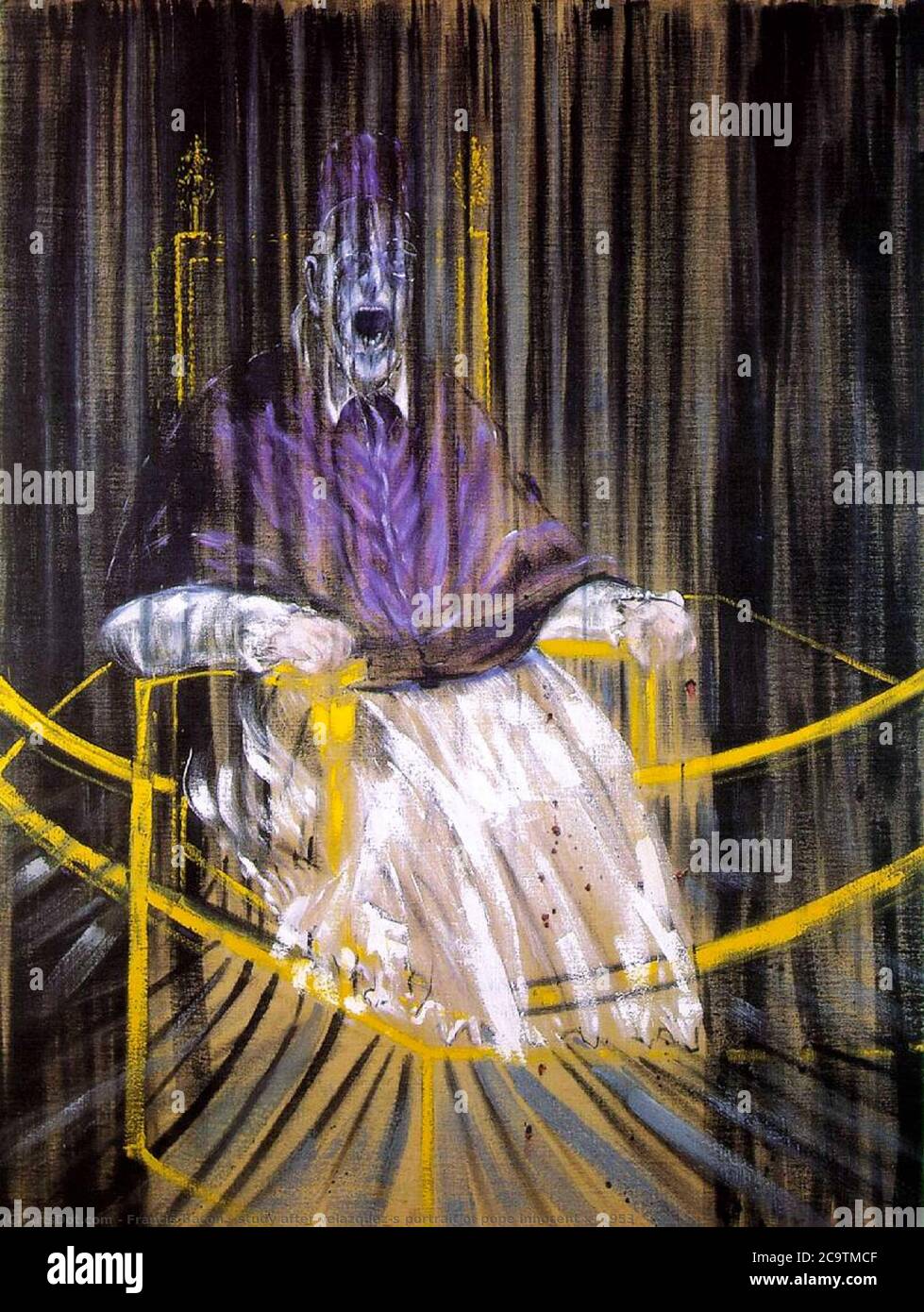Francis Bacon's Study After Velázquez's Portrait Of Pope Innocent X stands as one of the most haunting and enigmatic works in modern art. Created in 1953, this masterpiece reimagines Diego Velázquez's original portrait of Pope Innocent X from 1650, transforming it into a powerful exploration of human vulnerability and psychological turmoil. Bacon's interpretation captures not only the essence of the pope's authority but also delves deep into themes of existential dread and emotional distress.
Bacon’s work is celebrated for its ability to evoke raw emotion through distorted forms and unsettling imagery. By altering the serene visage of the pope into something more tormented, Bacon invites viewers to confront uncomfortable truths about power, identity, and mortality. His use of vibrant colors, dramatic lighting, and expressive brushstrokes adds layers of complexity to the piece, making it both captivating and disquieting. This article explores the riveting story behind this iconic painting and its enduring influence on contemporary art.
Rediscovering Velázquez Through Bacon's Lens
In his 1953 masterpiece, Francis Bacon revisits Diego Velázquez's renowned Portrait of Pope Innocent X, creating a bold reinterpretation that resonates with modern audiences. The original portrait depicts Pope Innocent X with regal composure, embodying the dignity and authority of the papacy. However, Bacon's version subverts these traditional notions, presenting the figure in a state of anguish and distortion. This transformation challenges viewers to reconsider the nature of power and the fragility beneath it.
Bacon's technique involves exaggerating facial features and blurring boundaries between reality and abstraction. The result is an image that appears to scream or writhe in agony, evoking emotions far removed from the calm demeanor of Velázquez's rendering. By emphasizing the psychological dimensions of the subject, Bacon crafts a narrative that transcends time, connecting viewers to universal experiences of fear and uncertainty.
The choice of Pope Innocent X as a subject was deliberate, as it allowed Bacon to explore themes of authority and corruption. Through his lens, the pope becomes a symbol of internal conflict rather than external grandeur. This shift underscores Bacon's fascination with exploring the darker aspects of humanity, inviting deeper reflection on the complexities of leadership and morality.
Artistic Fusion: Bacon Meets Eisenstein
What sets Bacon's Study After Velázquez's Portrait Of Pope Innocent X apart is its incorporation of cinematic elements. In addition to referencing Velázquez's painting, Bacon drew inspiration from Sergei Eisenstein's silent film The Battleship Potemkin. Specifically, he incorporated a still depicting a screaming nurse, which amplifies the sense of chaos and despair within the artwork. This fusion of visual and cinematic influences enriches the painting's emotional impact, drawing viewers into a world where art and film converge seamlessly.
Eisenstein's contribution serves as a bridge between classical portraiture and modern expressionism, highlighting Bacon's innovative approach to blending genres. The inclusion of filmic references introduces new dimensions of movement and sound, even though the medium remains static. This interplay between mediums enhances the painting's dynamism, ensuring that it continues to engage and provoke thought long after initial viewing.
Moreover, Bacon's decision to frame his work in gold aligns with traditional practices while simultaneously subverting them. By adhering to conventions associated with sacred or royal portraits, he heightens the irony inherent in his depiction of a distressed pontiff. Such attention to detail reinforces the duality present throughout the piece—celebration versus critique, reverence versus rebellion.
A Legacy of Influence
Since its creation, Bacon's reinterpretation of Velázquez's masterpiece has inspired countless artists across various disciplines. Its profound exploration of human emotion and the tension between tradition and innovation continues to resonate today. Many contemporary creators have drawn upon its themes, using it as a springboard for their own experiments with form and content.
One notable example comes from digital artist SK Altered, whose work Ad Naseum pays homage to Bacon's vision. Commissioned by client Justin N. Thring, this project integrates elements of magic card design with Bacon's aesthetic sensibilities. The resulting piece captures the same mood and psychological intensity found in the original painting, demonstrating how Bacon's legacy extends beyond fine art into popular culture.
Ultimately, Francis Bacon's Study After Velázquez's Portrait Of Pope Innocent X exemplifies the transformative power of artistic influence. By engaging deeply with historical works and integrating diverse sources, Bacon created a timeless masterpiece that challenges perceptions and inspires future generations. As we continue to explore its depths, we find ourselves reflecting not only on the nature of art itself but also on our shared human experience.

